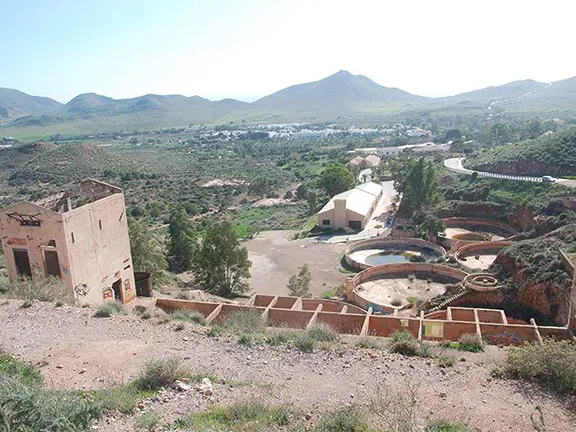Abandoned in 1966, the gold mining town of Rodalquilar in Nijar municipality, Almeria province, Andalucia is enjoying a tourist revival.
By Nick Nutter | Updated 11 Apr 2023 | Almería | Villages |
Login to add to YOUR Favourites or Read Later


Rodalquilar as seen from the gold mine
Rodalquilar, between San José and Las Negras in the Cabo de Gata, is a town built on gold. It sits in a volcanic caldera, now long extinct, that was created some 11 million years ago when a magma chamber collapsed. The igneous rocks contained veins of ore composed of lead, silver and gold. They were discovered in 1836.


Iglesia San Pedro Rodalquilar
A small cortijo, ‘El Estanquillo’, became the centre of a small village that called itself Rodalquilar. A few miners built poor houses in the valley. The fortunes of Rodalquilar depended entirely on the mine.


Abandoned miners houses Rodalquilar
At first, the mine owners were not particularly interested in the gold since it was only present in small concentrations and the ore containing the gold is hard, abrasive silica. Any gold in the ore was also expensive to extract so the value, initially, was in the lead and silver. The initial ‘gold rush’ soon fizzled out. That is until 1915 when free gold was discovered in one of the mines, allowing the owners to install plant machinery to extract metals from the ores. Until then all the ore had been shipped away for processing. Rodalquilar started to grow as more people became employed at the mines. Foreign investment helped expand the workings and the village.
In the early days, the ore was carried down to the Playa el Palayozo de Rodalquilar by donkey and cart where it was loaded onto ships that moored in the bay.


Strret scene Rodalquilar
In 1930 a British company, ‘Minas de Rodalquilar SA’ took over. They were responsible for the church in Rodalquilar and much of the colonial style housing. The church of San Pedro was originally called ‘St. Peter’ and the service was Anglican. This was the heyday for the village when the population reached over 1000. The mine was removed from British ownership only six years later, at the start of the Spanish Civil War. Its decline can be traced to that date. A combination of mismanagement, overproduction and competition saw the mine fail and close in 1966. The residents of Rodalquilar gradually drifted off until the village was effectively abandoned. The ruined houses can still be seen on the outskirts of the new village.


Video By: Julie Evans


Torre Alumbres
Slowly, Rodalquilar is being rejuvenated by tourists. Most of the sparkling white buildings are holiday apartments. A few cafes and artisan shops have also appeared to take advantage of a captive market. By 2014 the resident population had grown to 171.


Playa el Playozo de Rodalquilar
Some of the administration buildings associated with the mine have been renovated and are now used to promote various aspects of the village and the Cabo de Gata in general, including the long and secluded beach, Playa el Playozo, that is a favourite destination in summer.
El Albardinal is a Botanical garden specialising in plants endemic to the Cabo de Gata. The entrance is through a building built in 1935 to act as a guard house. After the Spanish Civil War, a detachment of Guardia Civil were stationed there. Their role was to guard the explosives used at the mine and the gold produced. Abandoned in 1982 it was restored in 2005.
The Botanical Garden is free to enter and open 9 am - 2 pm Tuesday, Wednesday, Thursday and Friday, 10 am - 2 pm and 4 pm - 6 pm on Saturdays and Sundays.
La Casa de los Volcanoes displays the geological history of Rodalquilar and the Cabo de Gata as well as a history of the mines. It is housed below the mine in smelting sheds that were part of the mine workings.
The House of Volcanoes is free to enter and open 10 am - 2 pm, Thursday, Friday and Saturdays.
Opposite the church you will come across the Visitors Centre. You will find information about the Cabo de Gata itself as well as the area around Rodalquilar.